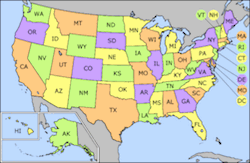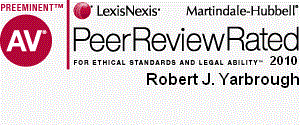Newsletter Issue 3 - May, 2009
In this issue:
State trademark registration
Patent reform - First to File vs. First to Invent
Don't forget trade secrets
$9.7 million trade secret judgment
State trademark registration
by Adam Garson
Lawyers often talk about the benefits of federal trademark registration. Federal registration bestows upon the trademark owner the ability to bring infringement actions in federal court, it provides evidentiary presumptions about use and validity of the mark, it bestows a presumption of incontestability (after 5 years), it provides constructive notice that the mark is yours, and federal law provides certain statutory remedies unavailable at common law. But what about registering your mark under state law? What benefits accrue to state registration when the benefits of federal registration are so sweeping? There are some, but not many.
State registration may be important if the owner is making purely intrastate use of its mark. In fact, the first requirement of registering your mark in a state registry is that you are using the mark in that state. Another benefit of state registration is cost. To file a trademark registration with the United States Patent and Trademark Office, the fee ranges between $275 and $375 per class of goods and services depending upon the type of application filed. In Pennsylvania, for example, the registration fee is $50.00, renewable every five years. Other states' fees are similar.
Registering your mark in a state registry, by providing a public record, also gives notice to potential registrants that you are using your mark. For example, the state registration will be revealed in trademark searches run by other potential users. Because trademark rights are tied to first use under United States law, evidence of first use is critical to prevailing in a trademark action. Thus, state registration may also establish prior use of the mark in an infringement action. It is worth noting, however, that trademark rights, while based upon use, are also tied to the geographic area in which the trademark is being used. So where a state registration is evidence of priority, it only extends to the state in which it is registered. State registration, therefore, may not be appropriate for businesses that conduct interstate activities or sell goods and services over the Internet to customers in other states.
Compared to the benefits of federal registration, the level of protection you receive from a state registration is limited. Perhaps, the best reasons for registering a trademark on the state level is where the owner's business activities are local and use by others of similar marks in other states is not important; and where the owner has limited financial resources but desires some level of protection. For any other situation, federal trademark registration provides more protection.
Patent Reform: 'First to file' vs. 'first to invent'
by Robert J. Yarbrough
If two inventors working independently create the same invention,
which one is entitled to a patent? Is it the person who invents first or the person who files a
patent application first?
Under current U.S. law, the person who is "first to invent" is entitled to the patent. In the rest of the world, the person who is "first to file" the patent application is entitled to the patent. The "Patent Reform Act of 2009," S. 515 and H.R. 1260, pending before Congress, would move the U.S. from 'first to invent' to 'first to file.'
Why should we care? The existing U.S. 'first to invent' system provides a benefit to U.S. inventors, particularly inventors with limited resources such as individual inventors, small businesses and academic institutions. The U.S. inventor can conceive of an invention and diligently develop the invention for up to one year without undergoing the expense of filing a patent application and without risk that an intervening publication will usurp the inventor's right to a patent. This is known as the 'one-year grace period.'
The proposed 'first to file' system largely eliminates the one-year grace period for filing a patent application. In the proposed 'first to file' system, an intervening publication by a third party will be prior art for the invention and can destroy the inventor's right to a patent.
The move to a 'first to file' system benefits companies that are frequent patent infringement defendants, such as Google, by making patents harder to obtain and easier to attack. In short, a 'first to file' system means fewer issued and enforceable patents.
The loss of the one-year grace period will have other consequences for the inventor. In the 'first to file' system, the inventor is under pressure to evaluate the invention and decide whether to file a patent application as soon as possible after conception. The inventor has only limited information at this early stage in development. The inventor may guess wrong as to whether to file and as to which embodiments of the invention to pursue. If the inventor guesses wrong and files patent applications for embodiments that turn out to have little value, the inventor has wasted money and time. If the inventor guesses wrong and fails to file an application for an invention that proves valuable, the inventor risks the loss of the invention to a later inventor or to subsequent prior art.
The 'first to file' system has the benefit of eliminating the transactional costs of priority fights by creating a hard-and-fast rule for priority between competing inventors.
For more information, see Margo Bagley, The Need for Speed (and Grace): Issues in a First-Inventor-to-File World, Berkley Technology Law Journal, Vol. 23, p. 1035 (2008) and Dennis Crouch's discussion of that article.
Don't forget trade secrets
by Adam Garson
Ask a knowledgeable layperson to define "Intellectual property" he or she typically lists patents, trademarks, and copyrights. A fourth type of intellectual property, "trade secrets," should not be ignored. Trade secrets consist of any idea, process, formula or other information that a company or individual wishes to protect from infringement (i.e., from being stolen) by maintaining it as a secret. Lawyers will tell you that to maintain trade secret protection, you must keep it secret. For some companies, that is not a problem. The Coca Cola Corporation, for example, has maintained the secrecy of its Coke formula for over a hundred years. For others, trade secret protection simply does not work. Disclosure of the "secret" process, idea or information is critical to their business model. Such companies seek patent, copyright or trademark protection.
Unlike its patent, trademark and copyright brethren -- creatures of federal law -- trade secret protection is controlled by state law. Until recently, this meant that the law of trade secrets was a patchwork of judge-made law ("common law"), which differed from state to state. The situation, however, has changed for the better. During the past 20 years, Pennsylvania (in 2004) and a majority of other states have adopted the Uniform Trade Secrets Act ("UTSA" or "Act"), which has added predictability to how trade secrets are treated under the law, making it a much more valuable tool for intellectual property protection, particularly for businesses involved in inter-state commerce.See 12 Pa. C.S.A. § 5301
The UTSA has standardized the definition of trade secret, the factors related to misappropriation of trade secrets, and the available remedies for violation of the Act. Under the Pennsylvania Act, a trade secret consists of "information, including a formula, drawing, pattern, compilation including a customer list, program, device, method, technique or process that derives independent economic value... from not being generally known to, and not being readily ascertainable by proper means by, other persons who can obtain economic value from its disclosure or use." Importantly, for businesses in Pennsylvania, the definition includes customer lists, which in some states are not considered trade secrets. Customer lists are frequently at the center of disputes between former employees and employers so the Pennsylvania UTSA provides businesses with another tool to defend their ownership rights so long as the lists are maintained in secrecy.
The Act requires that a trade secret be "subject of efforts that are reasonable under the circumstances to maintain its secrecy." So, if you have a customer list or any other type of trade secret you must use reasonable efforts maintain its secrecy. This means that access to the secret must restricted in a guarded location.
The UTSA provides remedies for the aggrieved party, including money damages and injunctions. Money damages may consist of defendant's unjust enrichment or plaintiff's lost profits. Alternatively, the UTSA also provides for reasonable royalties. In addition, punitive damages may be awarded for willful and malicious misappropriation. Under the Act, the prevailing party may also be awarded attorneys' fees. Finally, the UTSA provides criminal penalties and makes obtaining trade secrets "willfully and maliciously" through a computer or computer system a second-degree felony. See 18 Pa. C.S.A. § 3930
$9.7 million judgment in a trade secret case
by Robert J. Yarbrough
The United States District Court for the District of Utah Central Division has issued permanent injunctions and issued a judgment for approximately $9.7 in a case dealing with theft of trade secrets.
Clearone Communications alleged that two individuals appropriated computer code known as "honeybee code" in violation of an asset purchase agreement and in violation of an employment agreement. Wideband Solutions, a company in which the individuals participated, received the purloined code and licensed the code to Biamp Systems. After a jury trial, the Court found for plaintiffs. Applying the Utah version of the Uniform Trade Secrets Act, the Court awarded actual damages and punitive damages to Clearone and issued injunctions against the defendants. Defendants Wideband and Biamp have announced their intent to appeal.

